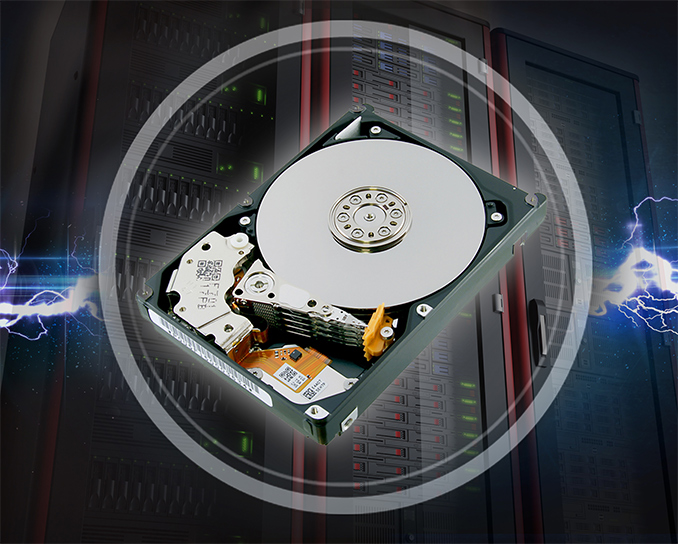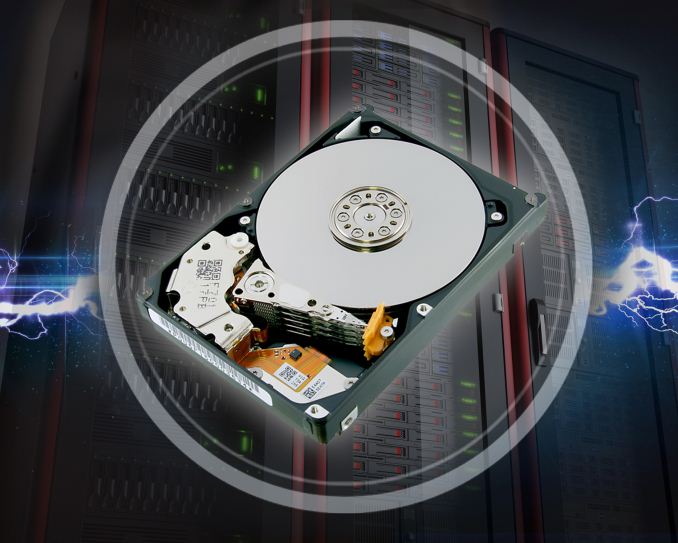Toshiba Samples AL15SE HDDs: Up to 2.4 TB, 10K RPM, SAS
by Anton Shilov on January 3, 2018 2:00 PM EST
Toshiba has announced that it has begun sampling of its new generation of SAS hard drives with a 10,500 RPM spindle speed. The new AL15SE HDDs are aimed at mission critical applications that still rely on traditional magnetic recording technology and have not yet migrated to SSDs. The key advantage of the new HDDs versus their predecessors are their increased capacity and performance.
The Toshiba AL15SE family of hard drives comes in traditional enterprise HDD form-factor of 2.5”/15 mm and includes models featuring Advanced Format (4K and 512e sectors) as well as SKUs with native 512B sectors. The AF hard drives can store 600 GB – 2400 GB of data (up from 1800 GB on the AL14SE), whereas the 512n hard disks have capacity of 300 GB – 1200 GB. The new drives are equipped with a 128 MB DRAM buffer as well as Toshiba’s persistent write cache with power loss protection (PWC with PLP). Select AL15SE models feature Sanitize Instant Erase (SIE) which encrypts and decrypts all data located on the drive and may delete the key when needed to quickly invalidate all recorded data. The SIE models take advantage of the persistent write cache with power loss protection.
| Toshiba AL15SE 10K 4Kn/512e HDDs | |||||||
| Capacity | 2.4 TB | 1.8 TB | 1.2 TB | 900 GB | 600 GB | ||
| Standard Model | 4Kn | AL15SEB24EP | AL15SEB18EP | AL15SEB12EP | AL15SEB09EP | AL15SEB06EP | |
| 512e | AL15SEB24EQ | AL15SEB18EQ | AL15SEB12EQ | AL15SEB09EQ | AL15SEB06EQ | ||
| SIE | 4Kn | AL15SEB24EPY | AL15SEB18EPY | AL15SEB12EPY | AL15SEB09EPY | AL15SEB06EPY | |
| 512e | AL15SEB24EQY | AL15SEB18EQY | AL15SEB12EQY | AL15SEB09EQY | AL15SEB06EQY | ||
| DRAM Cache | 128 MB DRAM | ||||||
| NAND Flash Cache | Toshiba’s persistent write cache with power loss protection | ||||||
| Form-Factor, Interface | 2.5", dual-port SAS 12 Gbps | ||||||
| Sustained Transfer Rate | 260 MB/s | ||||||
| Average Latency | 2.86 ms | ||||||
| Power Consumption | Read/Write | 8.7 W | 8.1 W | 7 W | 6.5 W | ||
| Active Idle | 5.1 W | 4.6 W | 3.5 W | 3 W | |||
| Warranty | 5 years | ||||||
| MTBF | 2,000,000 hours | ||||||
The new AL15SE drives are based on new platters with an increase in areal density. The new platters boost sustained data transfer speed of AL15SE AF HDDs over the prior AL14SE generation by 15% to 260 MB/s (outer diameter). The AL15SE 512n hard disks versions (while slower than their AF models at 225-234 MB/s), are also faster when compared to their predecessors. When it comes to latency, the drives feature a 2.86 ms average latency time, in line with previous-gen AL14SE products. Random performance of hard drives in general is typically very low and in case of 10K HDDs we are talking about ~200 IOPS. As for power consumption, the AL15SE consume 6.5-8.7 W, depending on SKU.
| Toshiba AL15SE 10K 512n HDDs | ||||||
| Capacity | 1.2 TB | 900 GB | 600 GB | 300 GB | ||
| Standard Model | AL15SEB120N | AL15SEB090N | AL15SEB060N | AL15SEB030N | ||
| SIE | AL15SEB120NY | AL15SEB090NY | AL15SEB060NY | AL15SEB030NY | ||
| DRAM Cache | 128 MB DRAM | |||||
| Form-Factor, Interface |
2.5", dual-port SAS 12 Gbps | |||||
| Sustained Transfer Rate | 234 MB/s | 222.5 MB/s | ||||
| Average Latency | 2.86 ms | |||||
| Power Consumption | Read/Write | 8.1 W | 7 W | 6.5 W | ||
| Active Idle | 4.5 W | 3.5 W | 3 W | |||
| Warranty | 5 years | |||||
| MTBF | 2,000,000 hours | |||||
Earlier this year Toshiba announced what could be the final generation of its hard drives with a spindle speed of 15,000 RPM. However now it follows up with its new 10K HDDs. Neither 10K nor 15K hard disks deliver performance levels comparable to mission-critical SSDs, but there are still many applications that rely on mechanical drives (especially if you run something old, which still uses 512B and similar sectors). Toshiba says that 10K and 15K HDDs are sold with a huge premium and even despite of decreasing unit shipments they still control around 10% of the global hard drive revenue share, which is why both Seagate and Toshiba refreshed their new 10K/15K product families in the recent 18 months.
Toshiba did not say when it plans to start commercial shipments of the new drives, but since we are dealing with HDDs aimed at mission critical applications, neither the manufacturer nor its clients would rush deployment. Prices of the drives will depend on volumes and negotiations.
Related Reading
- Toshiba Announces 14 TB PMR MG07ACA HDD: 9 Platters, Helium-Filled, 260 MB/s
- Toshiba Launches MN06ACA 10 TB HDD for NAS: 7 Platters, Up to 249 MB/s
- Toshiba Unveils 10TB HDDs for Video Surveillance: Support for up to 64 HD Streams
- Toshiba Announces 10 TB MG06ACA HDD: Seven Platters, 249 MB/s, NAND Cache
Source: Toshiba













23 Comments
View All Comments
ddrіver - Wednesday, January 3, 2018 - link
You're right, I mean it's not like they're paid by the same publication and have the same target: to report on the news. I'm sure all the guys who are allowed to write about Intel are on vacation or something.Dan, you've been known to miss some pretty obvious points but it looks like you're going for the record.
ddrіver - Wednesday, January 3, 2018 - link
And by the way, it's not that I hate AT. Actually this has been my absolute number 1 source of tech info for years. Why hate me for holding the current editorial team to high standards? I expect them to deliver like when Anand was still part of that team. And they don't.You blame me, hate me, or insult me for pointing out something that is objectively true as if I am the one responsible for this. In the past years you can see an obvious trend and a strong Intel bias here. Bad news are delayed, positive news are always at hand on the front page, everything that is competition gets put on the back burner (if I remember correctly Intel forgot to report on the Threadripper or Epyc launch for weeks during which time the front page was flooded by dozens of Intel articles).
And mind you, the guy who should handle the in depth articles on the kind of topic I'm talking about was available just 2 days ago to post a lengthy report on an Intel product reported with scarce details only on the Intel India page. https://www.anandtech.com/show/12207/intel-with-ra...
More time is allocated to rumors about a product that to what looks like one of the biggest security bugs in recent history, affecting every CPU going back at least a decade, a bug who's fix incurs up to 35% performance penalty!!! Big news! Pretty quiet here on AT no?
So hate me all you want. Your real problem is that you know I'm right and that you have to admit it at least to yourselves.
supdawgwtfd - Wednesday, January 3, 2018 - link
Have to agree with ddriver here...As soon as I saw reports about the bug I got anandtech up for details.
Nothing.
Went elsewhere.
As he said... Potentially biggest security bug that is in hardware that goes back a decade which to fix will hurt performance...
People are interested in that.
wuzy - Wednesday, January 3, 2018 - link
Another agreeing with ddriver here.It's been at least 13 hours as of this post, and counting. Still nothing from AT about the Intel CPU kernel bug. 13 hours is plenty of time report it.
Hurr Durr - Wednesday, January 3, 2018 - link
Didn`t you know that AT was one person writing under pseudonyms all this time? Let the man have his sleep.Lord of the Bored - Thursday, January 4, 2018 - link
Actually, now that the embargo is over and the security reports are public... the early hints that it was a big Intel bug were misleading at best.There's two bugs, codenamed Meltdown and Spectre. Meltdown was only demonstrated as an effective exploit on Intel parts. AMD is apparently vulnerable, but far more difficult to exploit. AMD is apparently spinning this as "we aren't vulnerable."
Spectre, on the other hand, is demonstrably usable on Intel, AMD, and more. It actually isn't even tied to processor architecture, as it was demonstrated as a valid attack against ARM processors as well.
Both exploits are similar in that they take advantage of interactions between CPU cache and out-of-order execution behaviors to capture data from memory that the process shouldn't have access to.
x86-wise, basically every processor released since the Pentium is vulnerable. Exceptions include Atoms released before 2013, and... that's it.
Pentium 2s are vulnerable, Thunderbirds are vulnerable, Pentium 4s are vulnerable, Sledgehammers are vulnerable, Core 2s are vulnerable, Zen is vulnerable. If it has out-of-order execution, it is vulnerable.
The answer to "is my system affected" is unusually simple in this case, as there are so few qualifiers.
That's the danger of reporting on rumors. Everyone else has piled onto the rumor mill and heaped speculation on top of hearsay and now everyone thinks this is Management Engine Rootkit 2 when it is actually something far more widespread. It makes friggin' Heartbleed look like a niche issue.
Anandtech has shown a reluctance in the past to report on rumor and hearsay, so no one should be surprised they haven't posted an article on Meltdown and Spectre yet. It makes them appear late to the party sometimes, but it also results in them offering less misinformation as fact.
close - Thursday, January 4, 2018 - link
A news story can always develop, that's not a good reason to completely ignore it. You'd end up never reporting anything because some details can change.https://arstechnica.com/gadgets/2018/01/whats-behi...
https://arstechnica.com/gadgets/2018/01/meltdown-a...
It's pretty detailed, might have some developments. But I'll take it instead of silence. I more or less gave up on AT. In depth articles are good but not when they come after everybody else gives you the same details.
Lord of the Bored - Friday, January 5, 2018 - link
The first article was largely speculative, and wound up being part wikipedia article about virtual memory, part hopeful speculation, and part *just plain wrong.*The second article was rushed, and missed important chunks of the whitepapers, like the part where they had limited success with Meltdown on AMD and ARM processors and it isn't just an Intel problem.
I particularly liked where Ars claims "neither one is sufficient on its own to, for example, break out of a Web browser", when the Spectre whitepaper details a Javascript implementation to do exactly that.
I do understand that audiences demand an article as soon as the rumor mill starts rolling, or within minutes of a press release, but... there are advantages to waiting until there is actual information to process. Advantages like not spending spend two days telling people about a devastating security flaw in Intel processors that is actually a collection of security flaws in post-1995 processor design. And personally, I value ACCURATE news over fast news.
XabanakFanatik - Thursday, January 4, 2018 - link
Can you cite a source about AMD being technically vulnerable to Meltdown?Lord of the Bored - Thursday, January 4, 2018 - link
Meltdown whitepaper, section 6.4https://meltdownattack.com